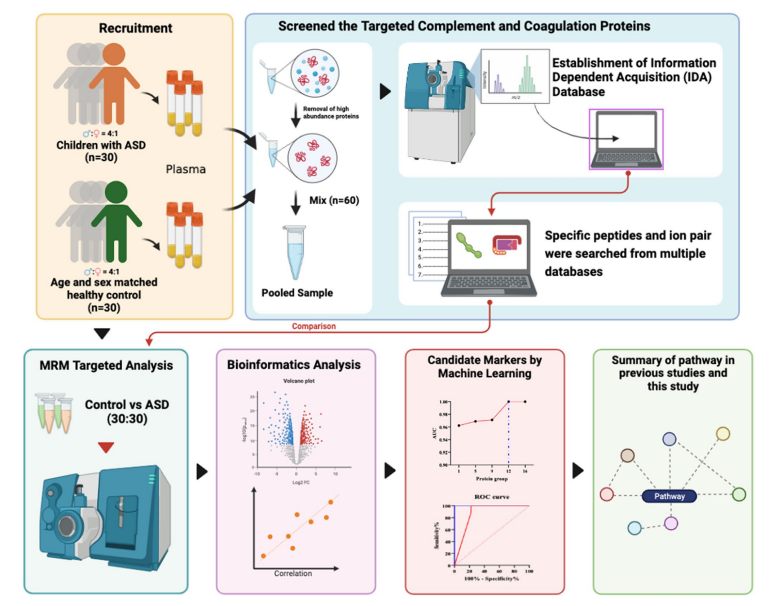MRM Mass Spec Service
Multiple Reaction Monitoring (MRM) is a highly sensitive and selective mass spectrometry detection technique that plays a crucial role in various fields. The core principle of MRM mass spec service lies in monitoring specific ion transition pathways to detect characteristic ion fragments of target compounds in complex samples with high sensitivity and specificity.
In MRM mass spectrometry analysis, the sample is first introduced into the mass spectrometer, where it is ionized into charged ions via an ionization source such as electrospray ionization (ESI). The first stage of the mass spectrometer (MS1) selects the precursor ion of the target compound, which is then fragmented into characteristic product ions through techniques such as collision-induced dissociation (CID). Subsequently, the second stage of the mass spectrometer (MS2) selects and monitors specific product ions. By predefining precursor-product ion pairs (transitions), the mass spectrometer can precisely detect the characteristic ion fragments of the target compound, enabling accurate quantification.
MRM offers ultra-high sensitivity, allowing for the detection of target substances even at trace levels, ensuring precise quantification. Additionally, MRM mass spec service provides outstanding selectivity by employing dual filtering mechanisms to accurately isolate target ions and specific product ions from complex ion mixtures. This effectively eliminates background interference, significantly improving the accuracy of the results.
Analysis Workflow
As illustrated in Figure 1, the MRM multiple reaction monitoring mode operates as follows:
Q1: Selects the precursor ion with a specific mass-to-charge ratio (m/z).
Q2: The precursor ion undergoes collision with nitrogen molecules in Q2, leading to fragmentation into product ions.
Q3: The fragmented product ions enter Q3, where they are scanned and filtered for specific m/z values. Only selected product ions can pass through Q3 and reach the signal detector.
Q1 and Q3 function as ion filters, while Q2 primarily serves to fragment the target ions into product ions. This scanning mode specifically selects precursor ions and their corresponding product ions, significantly enhancing selectivity and effectively reducing false-positive rates.

Snyman, T. et al. Methods in molecular biology, 2022.
Figure 1. MRM Technology Flow.
Services at MtoZ Biolabs
MtoZ Biolabs is equipped with multiple types of mass spectrometers, integrating high resolution, stability, high sensitivity, and fast scanning capabilities into a comprehensive mass spectrometry system. Our one-stop MRM mass spec service provides advanced technical support for researchers in biochemistry, biotechnology, and biopharmaceutical fields. The service includes MRM method development and optimization, selection of specific peptide fragments, isotope-labeled peptides, mass spectrometry analysis, raw data analysis, and bioinformatics analysis. Simply provide us with the target protein information for your study, and we will handle all subsequent aspects of the project.
Service Advantages
1. Advanced Analytical Platform
MtoZ Biolabs has established a state-of-the-art MRM mass spec service platform, ensuring reliable, rapid, and high-precision analytical services.
2. Transparent Pricing
Our pricing is transparent, with no hidden or additional fees.
3. High-Quality Data
Our service ensures deep data coverage with strict quality control measures.
4. Customized Research Solutions
MtoZ Biolabs provides tailored solutions to meet your unique research questions and experimental requirements.
Applications
1. Biomedical Research
MRM technology is widely used in proteomics research for quantitative analysis of target proteins, including protein expression levels, post-translational modifications, and subcellular localization. It is also employed in disease biomarker screening and validation, facilitating the understanding of disease mechanisms by quantifying biomarker expression in tissues or body fluids.
2. Pharmaceutical Research and Development
In drug metabolism studies, MRM mass spec service enables highly accurate and sensitive real-time monitoring of drugs and their metabolites, making it widely applicable in pharmacokinetic research. It is also used for quality control in biopharmaceuticals, such as quantifying post-translational modifications in monoclonal antibody drugs.
3. Food Safety Testing
MRM technology allows for the quantitative analysis of nutrients, additives, and prohibited drug residues in food, providing high sensitivity and specificity to ensure food safety.
4. Environmental Monitoring and Analysis
In environmental monitoring, MRM mass spec service is used to detect heavy metal ions and organic pollutants in water and soil samples, delivering highly sensitive and specific analytical results.
5. Clinical Diagnosis and Treatment
MRM technology is applied in the quantitative detection of disease biomarkers in clinical samples, assisting in disease diagnosis and treatment monitoring. For instance, in cancer treatment, it helps evaluate therapeutic efficacy by quantifying changes in tumor biomarkers.
Case Study
1. Systematic Analysis of Complement and Coagulation-Related Proteins in Autism Spectrum Disorder Using MRM Technology
Autism spectrum disorder (ASD) is one of the most common neurodevelopmental disorders in children, with potential alterations in complement and coagulation pathways. Researchers applied MRM proteomics technology to analyze 33 proteins involved in these pathways, identifying 16 differentially expressed proteins in the plasma of ASD children compared to healthy controls. Among these, CFHR3, C4BPB, C4BPA, CFH, C9, SERPIND1, C8A, F9, and F11 were identified as altered in ASD children's plasma for the first time. Notably, SERPIND1 expression showed a positive correlation with the Autism Diagnostic Observation Schedule (ADOS) scores. Using machine learning techniques, a network of 12 differentially expressed proteins was constructed, showing potential for ASD diagnosis. Additionally, researchers investigated proteins altered in both the brain and blood of ASD patients, revealing that the complement and coagulation pathways might be activated in the peripheral blood of ASD children and play a crucial role in ASD pathogenesis.

Cao, X. et al. Neurosci. Bull, 2023.
Figure 2. Research Roadmap of Complement and Coagulation-Related Proteins in ASD.
MtoZ Biolabs, an integrated Chromatography and Mass Spectrometry (MS) Services Provider, provides advanced proteomics, metabolomics, and biopharmaceutical analysis services to researchers in biochemistry, biotechnology, and biopharmaceutical fields. Our ultimate aim is to provide more rapid, high-throughput, and cost-effective analysis, with exceptional data quality and minimal sample consumption. Free project evaluation, welcome to learn more details!
How to order?







